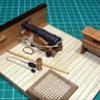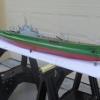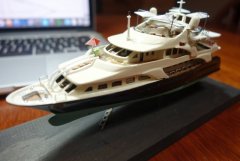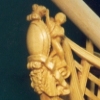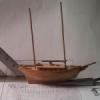Supplies of the Ship Modeler's Handbook are running out. Get your copy NOW before they are gone! Click on photo to order.
×
-
Posts
5,869 -
Joined
-
Last visited
Reputation Activity
-
 BANYAN got a reaction from Piet in Hr. Ms. O16 by cog - FINISHED - Pacific CrossRoads - 1:350 - Resin & PE
BANYAN got a reaction from Piet in Hr. Ms. O16 by cog - FINISHED - Pacific CrossRoads - 1:350 - Resin & PE
I would have thought chicory - isn't that used for smoking (meat etc)
cheers
Pat
-
 BANYAN got a reaction from Piet in Hr. Ms. O16 by cog - FINISHED - Pacific CrossRoads - 1:350 - Resin & PE
BANYAN got a reaction from Piet in Hr. Ms. O16 by cog - FINISHED - Pacific CrossRoads - 1:350 - Resin & PE
Hi Carl, I have been watching this 'additional' build of yours for a while, but thought I should comment on the great finish you have achieved. A lovely little model. As they look like an elaborate pipe, perhaps on a 'pipe stand' ?
cheers
Pat
-
 BANYAN got a reaction from Piet in Young America 1853 by EdT - FINISHED - extreme clipper
BANYAN got a reaction from Piet in Young America 1853 by EdT - FINISHED - extreme clipper
Ditto, I have already gained so much from your Naiad books and this log; I look forward to my Christmas present (YA Vols 1 and 2) but, in particular, I am looking forward to the next volume on rigging.
cheers
Pat
-
 BANYAN got a reaction from semorebutts in Please help! What to buy.
BANYAN got a reaction from semorebutts in Please help! What to buy.
Hi all, I have become a real fan of resistance soldering due to the control you have over it. I have been able to do some intricate work without heat sinks by placing the probes, and the solder, in the right place, The solder will draw towards the heat, and by using differing melting point solders, able to achieve this. The biggest issue with PE is that if you are not carefull you can blow through it very quickly with excessive heat.
The pissdales below still need cleaning up but as you can see these are only 4.5mm and the two end pieces (triangular) and the tubes were soldered in without heatsinks.
cheers
Pat
-
 BANYAN got a reaction from Omega1234 in Hr. Ms. O16 by cog - FINISHED - Pacific CrossRoads - 1:350 - Resin & PE
BANYAN got a reaction from Omega1234 in Hr. Ms. O16 by cog - FINISHED - Pacific CrossRoads - 1:350 - Resin & PE
I would have thought chicory - isn't that used for smoking (meat etc)
cheers
Pat
-
 BANYAN reacted to cog in Hr. Ms. O16 by cog - FINISHED - Pacific CrossRoads - 1:350 - Resin & PE
BANYAN reacted to cog in Hr. Ms. O16 by cog - FINISHED - Pacific CrossRoads - 1:350 - Resin & PE
Thanks Pat, your comments, suggestions are always much apreciated.
A pipe stand ... Well, I have to admit, it does offer some worthwhile perspective ... Would you have a certain wood species in mind ... American Walnut, Oak, Cherry, Pear ... I am, though, still looking for the mouth piece, and the bowl to put the tobacco in ... I wouldn;'t want to put it in the stand upside down ...
-
 BANYAN got a reaction from EdT in Young America 1853 by EdT - FINISHED - extreme clipper
BANYAN got a reaction from EdT in Young America 1853 by EdT - FINISHED - extreme clipper
Ditto, I have already gained so much from your Naiad books and this log; I look forward to my Christmas present (YA Vols 1 and 2) but, in particular, I am looking forward to the next volume on rigging.
cheers
Pat
-
 BANYAN got a reaction from Omega1234 in Hr. Ms. O16 by cog - FINISHED - Pacific CrossRoads - 1:350 - Resin & PE
BANYAN got a reaction from Omega1234 in Hr. Ms. O16 by cog - FINISHED - Pacific CrossRoads - 1:350 - Resin & PE
Hi Carl, I have been watching this 'additional' build of yours for a while, but thought I should comment on the great finish you have achieved. A lovely little model. As they look like an elaborate pipe, perhaps on a 'pipe stand' ?
cheers
Pat
-
 BANYAN got a reaction from CaptainSteve in Hr. Ms. O16 by cog - FINISHED - Pacific CrossRoads - 1:350 - Resin & PE
BANYAN got a reaction from CaptainSteve in Hr. Ms. O16 by cog - FINISHED - Pacific CrossRoads - 1:350 - Resin & PE
Hi Carl, I have been watching this 'additional' build of yours for a while, but thought I should comment on the great finish you have achieved. A lovely little model. As they look like an elaborate pipe, perhaps on a 'pipe stand' ?
cheers
Pat
-
 BANYAN got a reaction from mtaylor in Young America 1853 by EdT - FINISHED - extreme clipper
BANYAN got a reaction from mtaylor in Young America 1853 by EdT - FINISHED - extreme clipper
Ditto, I have already gained so much from your Naiad books and this log; I look forward to my Christmas present (YA Vols 1 and 2) but, in particular, I am looking forward to the next volume on rigging.
cheers
Pat
-
 BANYAN reacted to EdT in Young America 1853 by EdT - FINISHED - extreme clipper
BANYAN reacted to EdT in Young America 1853 by EdT - FINISHED - extreme clipper
Young America - extreme clipper 1853
Part 246 – Main Topmast Backstays
The main topmast backstays are exactly like their foremast counterparts – two pairs of 10 ½" lines looped over the topmast head and secured to the channels with deadeyes by 5" lanyards. The alligator clamp holding one of the 16" backstay deadeyes in the first picture was very useful when tying the throat seizing and in setting the deadeye height.
The throat seizing is being tied in the next picture.
The two round seizings above the throat were made with a series of clove hitches. The easiest way that I have found to tie each hitch on these and on the ratline knots is shown below.
After tying an overhand knot one one leg of the stay the tweezers are placed through the loop in the line that is passed behind the stay. The tweezers are then used to grip the end and pull it through to form the hitch. This process goes very fast and yields a tight seizing from the first hitch. I am using three hitches on these.
The threading up of the aft deadeye lanyard on this side is being completed in the next picture.
The first tensioning is started in the next picture.
The linen lanyards are pretty stiff, so pliers are used to grip each leg in turn, pulling up on the inboard legs and down on the outboard until all four stays have about equal tension and the forward stay is taut as well. In the next picture the upper aft deadeye is being adjusted to make its face parallel with the stay.
This can be done by gripping all three of the outer lanyard legs and raising or lowering them until the deadeye faces are aligned.
The next picture shows the four fairleads for these stays ready to be lashed on.
The lashing thread was first glued to the perimeter groove on the inboard side to make these easier to lash up. The last picture shows the two starboard fairleads installed
The loose lashing ends will be trimmed later. The lanyards will be wound around the stay later after a final tension adjustment in a week or so.
Ed
-
 BANYAN got a reaction from cog in Captain Roy 1948 by russ - FINISHED - 1/48 scale - POB - Biloxi Lugger
BANYAN got a reaction from cog in Captain Roy 1948 by russ - FINISHED - 1/48 scale - POB - Biloxi Lugger
Third time lucky; it does look good Russ, even in 'rough' state.
cheers
Pat
-
 BANYAN got a reaction from mtaylor in IJN Ise 1944 by RGL - FINISHED - Fujimi - 1/350 - PLASTIC
BANYAN got a reaction from mtaylor in IJN Ise 1944 by RGL - FINISHED - Fujimi - 1/350 - PLASTIC
Nice collection Some pretty good detail in such small items Greg.
cheers
Pat
-
 BANYAN reacted to Louie da fly in 10th-11th century Byzantine dromon by Louie da fly - FINISHED - 1:50
BANYAN reacted to Louie da fly in 10th-11th century Byzantine dromon by Louie da fly - FINISHED - 1:50
The repairs to the planking are now complete:
I think I'll extend the gunwale up to the pencil line on the tail, which is how it was before the disaster. I think it will look better.
And the stringers are all in place. They look quite a bit better than I'd expected.
And I've been back to the figure carving in between times. This is the VIP passenger - Emperor Alexios Comnenos, who I chose because he was the one who initiated the use of fearsome animal heads to shroud the "business end" of the Greek Fire projectors, adding to the shock and awe.
Early stage -roughing out, which I call the Megatron stage - (look at his face)
He's sitting on a "portable throne" with a bolster behind him, which appears over and over again in contemporary representations. They were gilded and very ornate. Here is a contemporary picture of him, with Christ sitting a throne of this type, though the one I'm making has four fairly hefty legs - also a common feature. Hmm, I'll have to make a footstool as well.
I'll try to reproduce that as best I can at this scale.
Next stage - finer shaping
Next stage - nearing completion
Still quite a bit to do on him - smoothing off and trimming etc. And of course painting. My faces are getting better, but I just haven't been able to capture the slightly rogueish expression on his face.
My next project will be to make the framing to support the oars of the lower bank below deck level, standing in place of the oarsmen themselves.
Steven
-
 BANYAN got a reaction from mtaylor in Bismarck by Dan Vadas - FINISHED - GPM - 1:200 - CARD and PE
BANYAN got a reaction from mtaylor in Bismarck by Dan Vadas - FINISHED - GPM - 1:200 - CARD and PE
Glad to hear you were able to resolve it Danny; the model is looking very good.
cheers
Pat
-
 BANYAN got a reaction from mtaylor in Bismarck by Dan Vadas - FINISHED - GPM - 1:200 - CARD and PE
BANYAN got a reaction from mtaylor in Bismarck by Dan Vadas - FINISHED - GPM - 1:200 - CARD and PE
Hi Danny, you will get many conflicting results from google or similar searches as the direction was a design criteria and differed from ship Class to ship Class. Even to this day, ships have different propellor configurations to meet the design requirements, which are determined by the winning bidder/tender (and accepted by the Navy/Company) unless specifically detailed in the tender request/Contract. There are arguments offered about fuel economy versus maneuverability etc etc. for the different configurations. Also, as you have summised you need sufficient flow over the rudders to make them effective. Even with twin rudders, if they were not big enough, or incorrectly placed, they may not have been effective with a particular screw configuration.
Unless you can find a contract or authoritative document that states what the configuration was, I would recommend the best way to determine this would be to look at any photos of the screws if any exist. The pitch of the blades (I think they were all fixed pitch in these days) will indicate which way they turned? For the central screw, I would not be surprised if it turned in the same direction as the motor output to minimise gearing and complication. It may also be that this screw was only used if extra/the highest speed was needed. That does not help you determine the direction, but apart from the pitch, if you know the motor/engine type, it may be possible to trace that back as well to find it's mechanical properties .....
I would be very surprised that a ship of this fame did not have propulsion information, including about the screws, published about it somewhere.
cheers
Pat
-
 BANYAN got a reaction from mtaylor in Captain Roy 1948 by russ - FINISHED - 1/48 scale - POB - Biloxi Lugger
BANYAN got a reaction from mtaylor in Captain Roy 1948 by russ - FINISHED - 1/48 scale - POB - Biloxi Lugger
Third time lucky; it does look good Russ, even in 'rough' state.
cheers
Pat
-
 BANYAN got a reaction from mtaylor in Chebece 1750 by Jeronimo - FINISHED
BANYAN got a reaction from mtaylor in Chebece 1750 by Jeronimo - FINISHED
Great finish Karl - you never disappoint with the quality of your work.
cheers
Pat
-
 BANYAN got a reaction from Obormotov in MONTAÑES by Amalio
BANYAN got a reaction from Obormotov in MONTAÑES by Amalio
Thanks for the pointer Greg, you are absolutely right - I am even more impressed now!
cheers
Pat
-
 BANYAN got a reaction from Obormotov in MONTAÑES by Amalio
BANYAN got a reaction from Obormotov in MONTAÑES by Amalio
Fantastic detail and superb metal work. How do you form those gudgeons to have such clean and sharp angles? Do you file them from a solid piece?
cheers
Pat
-
 BANYAN got a reaction from mtaylor in SS Michelangelo 1962 by shipmodel - FINISHED - 1/350 scale
BANYAN got a reaction from mtaylor in SS Michelangelo 1962 by shipmodel - FINISHED - 1/350 scale
Nice work on the hull Dan, looks very good.
cheers
Pat
-
 BANYAN got a reaction from russ in Captain Roy 1948 by russ - FINISHED - 1/48 scale - POB - Biloxi Lugger
BANYAN got a reaction from russ in Captain Roy 1948 by russ - FINISHED - 1/48 scale - POB - Biloxi Lugger
Third time lucky; it does look good Russ, even in 'rough' state.
cheers
Pat
-
 BANYAN reacted to russ in Captain Roy 1948 by russ - FINISHED - 1/48 scale - POB - Biloxi Lugger
BANYAN reacted to russ in Captain Roy 1948 by russ - FINISHED - 1/48 scale - POB - Biloxi Lugger
Just a little more progress. This was the perfect day to work on the model. Nice cool, dry weather.
I am making some progress on the pilothouse. This pilot house differs from the trunk cabins I have built for schooners in that a lot of the interior is visible so I need to take some care to make sure that the interior details are presentable. This is all very rough right now, but it is coming along. The dashboard will have dials on it and the small bulkhead below it will have paneling and the wheel will be mounted just below the dashboard. There will be three windows in the openings across the front of the pilot house and the exterior will have vertical planking.
Russ
-
 BANYAN got a reaction from popeye the sailor in Bismarck by Dan Vadas - FINISHED - GPM - 1:200 - CARD and PE
BANYAN got a reaction from popeye the sailor in Bismarck by Dan Vadas - FINISHED - GPM - 1:200 - CARD and PE
Glad to hear you were able to resolve it Danny; the model is looking very good.
cheers
Pat
-
 BANYAN got a reaction from popeye the sailor in Bismarck by Dan Vadas - FINISHED - GPM - 1:200 - CARD and PE
BANYAN got a reaction from popeye the sailor in Bismarck by Dan Vadas - FINISHED - GPM - 1:200 - CARD and PE
Hi Danny, you will get many conflicting results from google or similar searches as the direction was a design criteria and differed from ship Class to ship Class. Even to this day, ships have different propellor configurations to meet the design requirements, which are determined by the winning bidder/tender (and accepted by the Navy/Company) unless specifically detailed in the tender request/Contract. There are arguments offered about fuel economy versus maneuverability etc etc. for the different configurations. Also, as you have summised you need sufficient flow over the rudders to make them effective. Even with twin rudders, if they were not big enough, or incorrectly placed, they may not have been effective with a particular screw configuration.
Unless you can find a contract or authoritative document that states what the configuration was, I would recommend the best way to determine this would be to look at any photos of the screws if any exist. The pitch of the blades (I think they were all fixed pitch in these days) will indicate which way they turned? For the central screw, I would not be surprised if it turned in the same direction as the motor output to minimise gearing and complication. It may also be that this screw was only used if extra/the highest speed was needed. That does not help you determine the direction, but apart from the pitch, if you know the motor/engine type, it may be possible to trace that back as well to find it's mechanical properties .....
I would be very surprised that a ship of this fame did not have propulsion information, including about the screws, published about it somewhere.
cheers
Pat


